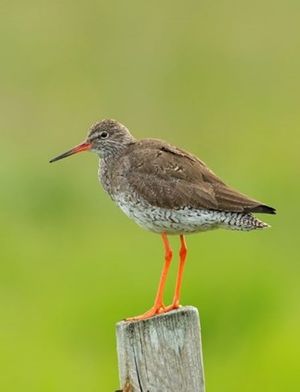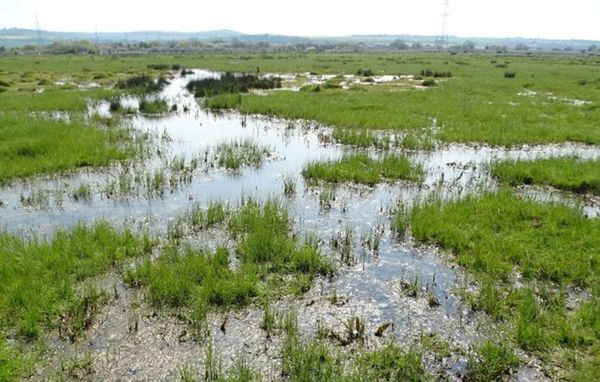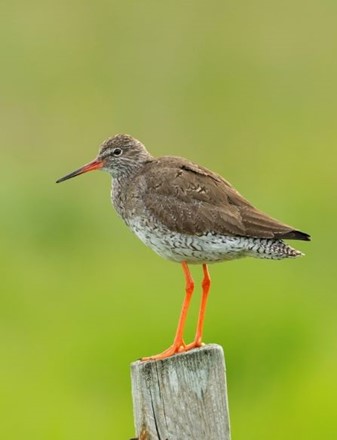 LINKED PAPER
LINKED PAPER
The effect of conservation interventions on the abundance of breeding waders within nature reserves in the United Kingdom. Jellesmark, S., Ausden, M., Blackburn, T.M., Hoffmann, M., McRae, L., Visconti, P. and Gregory, R.D. 2022 Ibis. doi: 10.1111/ibi.13106 VIEW
Wetlands provide crucial ecosystem functions and are among the most biodiverse ecosystems on earth. However, long-term data shows that natural wetlands are in steep decline around the world, disappearing at up to three times the rate of forest loss (Ramsar Convention on Wetlands, 2018). As a consequence, wetland-dependent species, such as wading birds (also called shorebirds – order Charadriiformes), are disappearing at alarming rates. In the United Kingdom (UK), waders once abundant, such as Northern Lapwing (Vanellus vanellus) and Common Redshank (Tringa totanus), are now much rarer with breeding grounds often confined to nature reserves and protected areas.
In response to this decline, the Royal Society for the Protection of Birds (RSPB) has created, restored and managed wetlands to benefit target species, such as waders. During 1990-2015 alone, the RSPB acquired and restored around 8750 ha of land in the UK, primarily to benefit wetland-dependent bird species (Ausden et al., 2019). Acquired sites are converted into wetlands by reseeding grasses, installing structures, such as dams, that allow control of high water levels, and reducing pressure from ground predators, using measures such as predator exclusion fencing. This type of reserve management has been shown to effectively improve breeding trends for target waders (Jellesmark et al., 2021). However, what drives breeding abundance inside reserves is still not fully understood. Often, studies are performed across a single or few sites, meaning that we don’t really know if a conservation action successful at one site would be as successful at another. Furthermore, we often lack detailed records of conservation information, making it difficult to evaluate the impact of conservation with any real confidence.

Figure 1 A lowland wet grassland site in good condition for breeding waders. The site contains a mixture of shallow, water-filled pools and rills that will gradually dry out in May and early June and provide feeding habitat for adult and young Lapwings and Redshank.
To improve our understanding of what leads to high numbers of breeding waders, we set out to collate information on reserve sites, such as their size and years since acquisition, but also the types of management actions being performed each year. Collating this data was a tedious task though. Hundreds of hours were spent browsing through old management reports trying to record exactly the type of management that was done on each reserve site (check the picture below). Each report had to be browsed through individually, as many exist only in physical paper format. I can only imagine the difficulties of being a researcher before computers became mainstream!

Figure 2 Hundreds of management reports ready for inspection!
Having spent months collecting this information with help from RSPB, we paired it all together to get a UK-wide comprehensive dataset containing annual numbers of breeding birds on RSPB reserve sites, reserve information, conservation actions and weather data, that we could then analyse with modern statistical methods. We limited the analysis to a particular type of wetland – lowland wet grassland – and the four wader species, Northern Lapwing, Eurasian Curlew (Numenius arquata), Common Snipe (Gallinago gallinago) and Common Redshank.
Not surprisingly, larger reserves generally support higher numbers of breeding waders; bigger is better. Similarly, older reserves also support higher numbers of breeding pairs with a particularly strong upwards trend in over the first couple of years. Excluding ground predators through predator fencing also seems important, especially in combination with fox control. However, findings varied substantially between sites, reflecting the difficulties of not only managing lowland wet grassland but also collating fine-grained datasets that cover large areas. We know that management effectiveness strongly depends on site-specific factors, which we were not always able to account for in this dataset and analysis.
Improving wetland conservation
It is becoming increasingly important to understand how different conservation actions impact biodiversity – after all, evidence-based decision making requires evidence! However, the resources and data that conservation scientists currently have available often do not permit inferences to be made with any high level of confidence. Evaluation of conservation actions has to be made a priority alongside consistent and standardized monitoring and recording of both biodiversity and conservation actions.
References
Ausden, M., Hirons, G. & White, G. 2019. Wetland restoration by the RSPB – what has it achieved for birds? British Birds 112: 315-336. VIEW
Jellesmark, S., Ausden, M., Blackburn, T.M., Gregory, R.D., Hoffmann, M., Massimino, D., McRae, L. & Visconti, P. 2021. A counterfactual approach to measure the impact of wet grassland conservation on UK breeding bird populations. Conservation Biology 35: 1575-1585. VIEW
Jellesmark, S., Ausden, M., Blackburn, T.M., Hoffmann, M., McRae, L. & Visconti, P. & Gregory, R.D. 2022. The effect of conservation interventions on the abundance of breeding waders within nature reserves in the United Kingdom. Ibis VIEW
Ramsar Convention on Wetlands. 2018. Global Wetland Outlook: State of the World’s Wetlands and their Services to People. Gland, Switzerland: Ramsar Convention Secretariat
Image credit
Top right: Redshank numbers are declining in the UK and breeding birds increasingly depend on nature reserves and other protected sites.
If you want to write about your research in #theBOUblog, then please see here.



